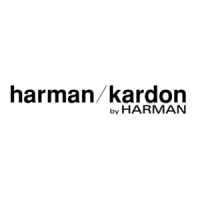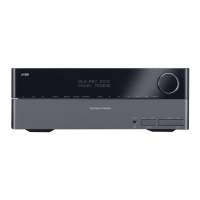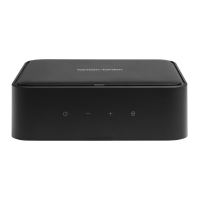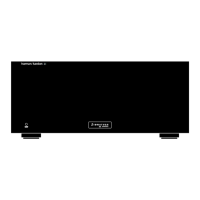Citation 7.0 Owner’s Manual
Preliminary Draft
Page # 59
Enitre Contents Copyright ©1995 - Harman Kardon Inc.
At the next menu the option of changing any one of the three sound stage positions is available. (figure #xx) Press
“Select” to modify the Front Soundstage, or use the “Г button to move the on screen “Ö“ pointer next to the
Soundstage you wish to modify.
NOTE: If your system has not been configured to include center, back or side speakers, the menus that
appear for the Soundstage settings may differ from those shown below. This is normal, as the 7.0 cannot create a
venue using speakers that it has not been configured for.
Front Stage
Four options are available, (figure #xx) mirroring the selections available at any time by pressing “Center Speaker” on
the remote. Making a change here, however, will mean that the selected option will take effect whenever the new
mode is selected. The options available are:
Narrow: This activates the center channel speaker, and provides a 3 db boost above the calibrated level for
that channel. This creates the effect of a narrowly focused center channel.
Normal: This is the normal setting for center channel operation. It activates the center channel at the calibrated
level.
Wide: This option creates a diffuse center channel effect by feeding a small amount of the center channel
signal into the left and right front channel speakers.
Extra Wide: This setting creates the effect of a very wide, or “phantom” center channel by turning the center
channel off.
Use the “Ï“ and “Г buttons to move the on screen “Ö“ pointer next to the desired center channel configuration.
Press “Select” to confirm the setting and note that the ““ cursor block will move next to your selection. Press
“Exit/OK” to enter the selection to memory and return to the Sound Stage menu.
Back Stage
At the next menu, press “Г to move the on screen “Ö“ pointer next to “Back Stage”. Press “Select” to move to adjust
the settings for this option.
Three choices are available for the back soundstage (figure #xx):
Narrow: This is the monophonic back channel presentation required by Dolby ProLogic and Home THX. In this
mode, the same signal will be sent to all back channel speakers when in ProLogic, and a mono decorrelated signal will
be sent to the back speakers in THX.
Wide: This option creates a stereo effect in the rear channels by feeding a small amount of the left front
speaker into the left back speakers, and a small amount of the right front into the right back speakers.
No Back Stage: Select this option if you do not wish to have the back channel speakers engaged in this mode.
Use the “Ï“ and “Г buttons to move the on screen “Ö“ pointer next to the desired back soundstage setting. Press
“Select” to confirm the setting and note that the ““ cursor block will move next to your selection. Press “Exit/OK” to
enter the selection to memory and return to the Sound Stage menu.
Side Stage
At the next menu, press “Г to move the on screen “Ö“ pointer next to “Side Stage”. Press “Select” to move to adjust
the settings for this option.
This menu contains an option that is unique to the Citation 7.0. The Six Axis configuration for the rear channels is an
exclusive Jim Fosgate design feature. It creates an enveloping sound field by carefully distributing sound among the
side and rear speakers to make it sound as though there are six separate sound sources in your listening
environment. Although there is no actual “center back” speaker present, the Six Axis mode provides sonic illusion of
the additional phantom speaker.

